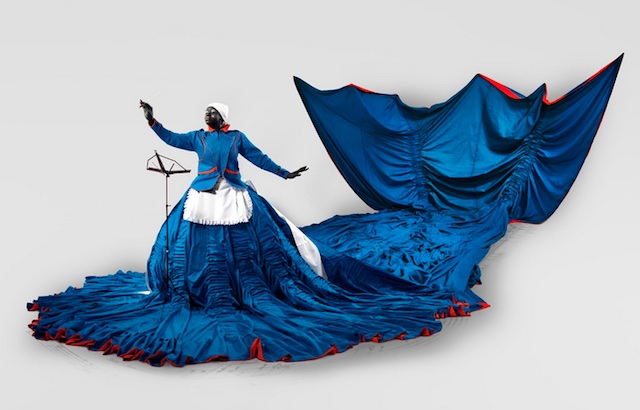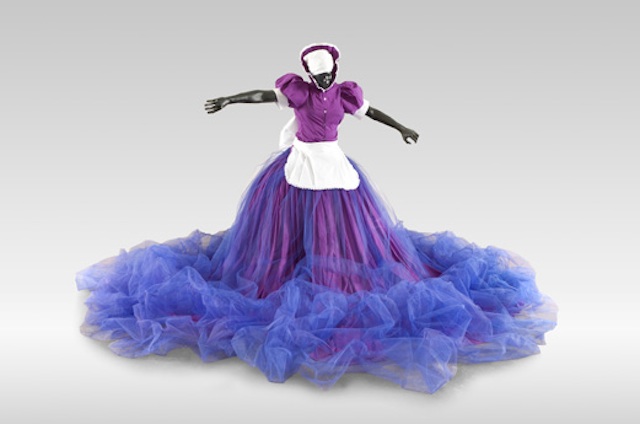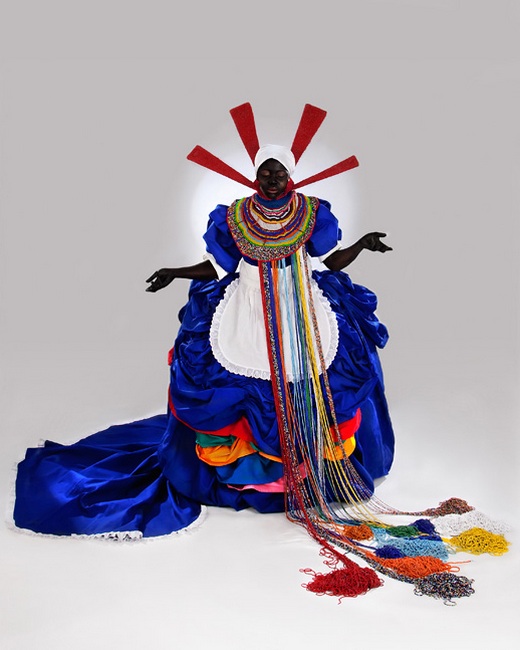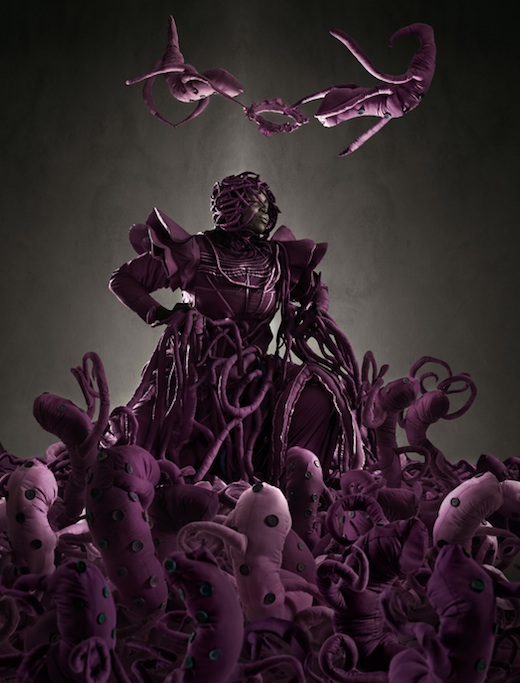
In September 1989, at an anti-apartheid rally in Cape Town, police sprayed protestors from a water cannon laced with purple dye in order to more easily identify and arrest them. The following morning a spray-painted response appeared: “The purple shall govern.” It turned out to be a prophecy.
That very phrase was the title of an exhibit this past summer by South African artist Mary Sibande. Grand in scale and political in its references — yet self-reflexive in its focus — it continued Sibande’s project of creating highly personal, and often fantastic, incarnations of women’s experiences in the stream of South African history.
Sibande is already well-known in South Africa, and she has a growing international reputation. Born in Barberton in 1982, the year of her birth is an important reference point to her emergence as an artist. Partly, it indicates how much she’s achieved while still young, but more significantly, it points to the fact that she came of age in post-apartheid South Africa.
With the passage of time, it’s almost possible to start forgetting how brutal apartheid was; however, from its formal institution in 1948 until its revocation in 1994, it plagued South Africa with injustices. Among these, it severely restricted the choices and movements of Black South Africans. For example, Sibande’s great-grandmother, grandmother, and mother (who had wanted to be a nurse) were forced to forfeit their personal ambitions and take jobs as domestic workers, as there was no other employment available to them.
As a young woman at the start of the new millennium, the opportunities available to Sibande were of a completely different order. This fertile ground was watered by her family’s mantra that Sibande should seize the opportunity to be whatever she wanted to be, and by Sibande’s own dawning understanding of the socio-political context around her. While she grew up comfortably, in high school she began to notice the socio-economic divides in her community, and also to grasp her uncles’ dinner table conversation about the regime change around them.

Sibande found herself drawn to the idea of storytelling. In 2002, she enrolled at the University of Johannesburg to take a National Diploma in Fine Arts. In 2007, while carrying on her studies toward a Fine Arts B-Tech degree at the same university, the respected South-African Curator Thembinkosi Goniwe asked Sibande to participate in Four Tales, a show he was mounting at the prestigious Gallery MOMO in Johannesburg. Its purpose was to showcase emerging talent, and all four women chosen to participate were still at university.
Influenced by the African-American artist Kara Walker, the British-Nigerian artist Yinka Shonibare, and the Spanish sculptor Juan Muñoz, Sibande not only adopted the role of artist-as-storyteller; she did something bold. She took as her subject her family’s experiences as domestic workers, and by implication, her own position as a free agent. She incarnated these real and imagined experiences in “Sophie”, a life-sized figure cast in fibreglass. Sophie represented both Sibande’s forebears and her own alter-ego, occupying a role she herself would never actually have to adopt.
Sophie’s initial outing in Four Tales spoke of what would come to be a running characteristic of Sibande’s work, and perhaps a key to its appeal: although her stories are intensely personal, they represent figures and themes that speak to the experiences of many. Sophie may be a family avatar, but the Black female domestic worker is a familiar, even iconic figure in the South African psyche. For Black South Africans, she was the family member who’d been pressed into service against her will. For white South Africans, she was the woman who had been part of the backdrop in their homes — the hand that rocked the cradle.
Though Sibande’s technique was “only just developing” at the time, Karen Brusch, the manager of Gallery MOMO, tells me that even this first appearance of Sophie in Four Tales caused a stir. Sophie was instantly recognizable as this iconic maid, but she simultaneously undermined her supposed identity in every way. If traditional maids were expected to be invisible, confined to kitchens and nurseries, Sophie demanded attention by taking up a disproportionate amount of space in a fantastic couture version of the traditional maid’s costume, complete with bustle and frilled hem. And instead of Sophie’s attention being fixed on her employer’s world and demands, her eyes were closed, focused on an inner landscape of desire and imagination.
The overwhelming response to Sibande’s first sculpture prompted Gallery MOMO to offer Sibande her own show less than a year later, and to invite her to participate in the Joburg Art Fair in the interim. In these two shows, Long Live the Dead Queen and They Don’t Make Them Like They Used To, and in later work, Sibande allowed Sophie to move further into her dreamscape. In commanding exhibits and photographic artworks disconcerting for their ambiguity (was Sophie a sculpture, or perhaps a representation of Sibande herself?), Sophie wore regal confections that might spill on for metres or rise up around her like sea foam. She could do anything: ride a rearing horse, lead men into battle, speak with other powerful women, or seemingly escape imprisonment through rapture.

From these first exhibits, Sibande’s career has progressed with a speed and drama worthy of one of Sophie’s fantasies. To some degree, Brusch says, Sibande’s career has been driven more by galleries and the media’s hunger for her work, alongside her intense work ethic, than it has been by any specific ambition on Sibande’s part. Regardless, these factors combined led to a number of international residences and numerous solo and group shows. Amongst them: the 54th Venice Biennale in 2011, the Smithsonian in 2012, and a show of South African contemporary art at La Maison Rouge in Paris in 2013. She’s also become a public face of art in South Africa, in part through her participation in an innovative project during 2010’s World Cup in Johannesburg. Drawing on her exhibit Long Live the Dead Queen, Sibande’s sculptures and photographs were enlarged into giant billboards which wrapped nineteen buildings, turning the urban core into a public art gallery. The city was taken with “the figure in the blue dress”, and suddenly, Sophie was as recognizable as any brand.
However, this success has created enormous pressure for Sibande. As she explained to me earlier this year, she continues to want to see herself as a storyteller, not as a brand. She also faces the inevitable constraints of the successful artist. She wants to impress, but resists being held on a leash. As Brusch observed, this is complicated by the fact that after so many successes, audiences expect Sibande to continually “come up with magic.”
In a way, Sibande’s dilemma could be thought of as a kind of metaphor for the new South Africa. Sibande has real and measurable freedoms that her forebears did not, yet those same freedoms create new pressures, constraints, and accountabilities. Though this is perhaps a fanciful notion, I wondered if I heard reference to it in the way that Sibande’s use of the concept of freedom evolved over the course of our conversation. At first, she described it in blunt terms as “the ability to do what I want, when I want.” Later, though, she mused that freedom can be a monster, “an octopus with many legs and hands.”
Sibande’s ambivalent feelings about the nature of freedom are highly visible in The Purple Shall Govern. Though the work contains the familiar fibreglass figure, and once again makes sweeping use of space, it differs starkly from what she has done before. Perhaps most significantly, that familiar figure is actually no longer Sophie. She is gone, sent into “hibernation”, so that a new figure — perhaps a doppelgänger of Sibande herself — can come into focus. Now, the defiant female figure is enmeshed in swirling and menacing tentacles. Sometimes they are creeping up her dress; sometimes she seems lost in thickets of them.
Given its title, The Purple Shall Govern appears to be clear-cut in terms of its political references. And indeed, Sibande told me that she wanted to highlight not just South African history, but the way in which colour has been an enduring theme in South Africa. “Colour remains a predominant factor in our social interactions and it continues to play a dominant role in our perceptions of one another as South Africans. In my view, it is like a monster that we are all too familiar with.”
And yet, as with Sibande’s previous works, politics is just one part of the story. Her work is personal, as well. Sibande said that The Purple Shall Govern presents “the next chapter, in which I speak of my own aspirations, desires, fears, and anxieties of being a woman.” The viewer is taken not just into Sophie’s mind and dreamscape, but seemingly within this new figure’s body itself, with its rawness, power, and strange beauty.

It is perhaps Sibande’s insistence on the interrelationship between body, mind, and context that paradoxically makes this highly personal, politically-situated work in fact so universal. We are all bodies and minds caught in a web of history, negotiating moments in time. We know power, fear, and rapture. And we might, in our own way, be able to relate to the project of a young woman to find her place and time, and to live up to others’ expectations — and her own.

